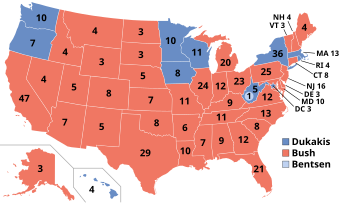| ← 1986 1987 1988 1989 1990 → Presidential election year | |
| Election day | November 8 |
|---|---|
| Incumbent president | Ronald Reagan (Republican) |
| Next Congress | 101st |
| Presidential election | |
| Partisan control | Republican hold |
| Popular vote margin | Republican +7.8% |
| Electoral vote | |
| George H. W. Bush (R) | 426 |
| Michael Dukakis (D) | 111 |
 | |
| 1988 presidential election results. Red denotes states won by Bush, blue denotes states won by Dukakis. Numbers indicate the electoral votes won by each candidate. | |
| Senate elections | |
| Overall control | Democratic hold |
| Seats contested | 33 of 100 seats |
| Net seat change | Democratic +1 |
 | |
| 1988 Senate results
Democratic gain Democratic hold | |
| House elections | |
| Overall control | Democratic hold |
| Seats contested | All 435 voting members |
| Popular vote margin | Democratic +7.7% |
| Net seat change | Democratic +2 |
 | |
| 1988 House of Representatives results
Democratic gain Democratic hold | |
| Gubernatorial elections | |
| Seats contested | 14 (12 states, 2 territories) |
| Net seat change | Democratic +1 |
 | |
| 1988 gubernatorial election results Territorial races not shown Democratic gain Democratic hold | |
The 1988 United States elections were held on November 8 and elected the president of the United States and members of the 101st United States Congress. Republican Vice President George H. W. Bush defeated Democratic Governor of Massachusetts Michael Dukakis. Despite Dukakis' defeat, the Democratic Party built on their majorities in Congress.
In the 1988 presidential election, Republican Vice President George H. W. Bush defeated Democratic governor Michael Dukakis of Massachusetts.[1] Bush won the popular vote by just under eight points, and won 426 of the 538 electoral votes. Bush won the Republican nomination over Kansas senator Bob Dole and televangelist Pat Robertson of Virginia. Dukakis won the Democratic nomination over Reverend Jesse Jackson of Illinois, Tennessee senator Al Gore, and Missouri Congressman Dick Gephardt. Bush's victory remains the only time since Harry S. Truman's victory in the 1948 presidential election in which either party won more than two consecutive presidential elections.
Neither the Senate nor the House saw any significant partisan change, and the Democratic Party retained control of both chambers. In the gubernatorial elections, the Democratic Party picked up one governorship. This was the first election since 1960 to see the winning presidential candidate's party fail to have any coattails in either house of Congress. This is the second and most recent time since 1889 that a newly elected president's party did not control either house of Congress.
- ^ "1988 Presidential Election". The American Presidency Project. Retrieved 13 August 2011.